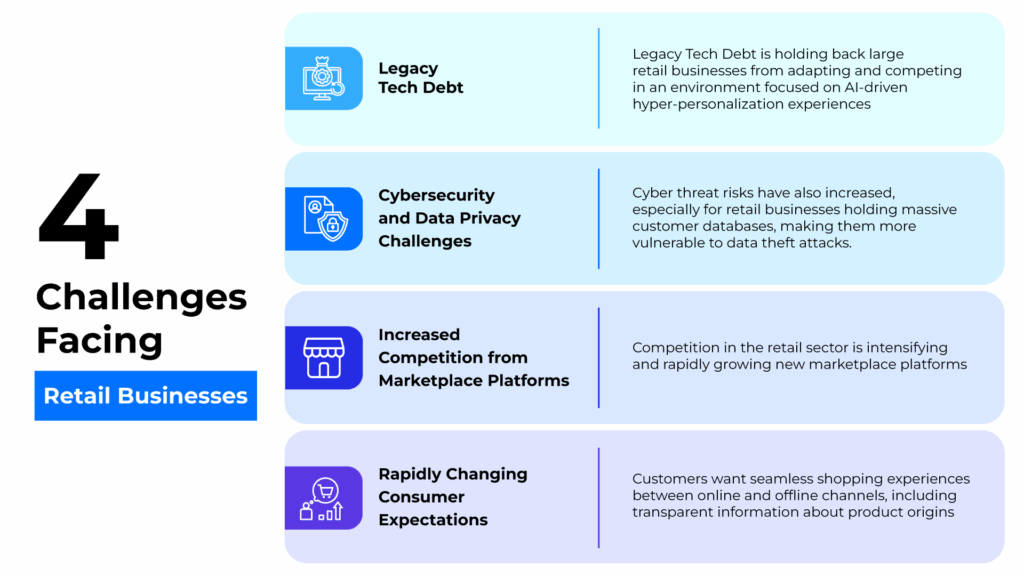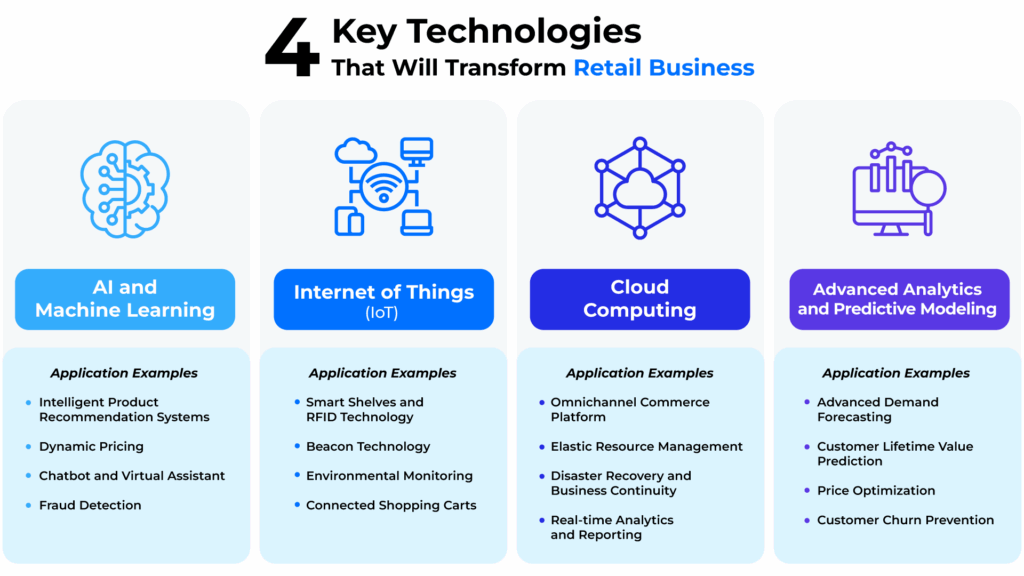Enterprise Transformation: Key to Tackling Challenges and Creating Competitive Advantages for Retail Business
Key Takeaways:
- New Trends and Challenges: The retail industry is facing major transformation driven by the shift from Mass-to-Micro personalization, Unified Commerce that surpasses Omnichannel, and sustainability becoming a core strategy. Key challenges include Legacy Tech Debt, cybersecurity threats, and intensified competition from major platforms like Amazon, Walmart, and emerging marketplaces.
- Key Technologies Transforming Business: AI and Machine Learning for intelligent product recommendations and dynamic pricing, IoT for connecting physical and digital worlds through smart shelves and environmental monitoring, Cloud Computing as the foundation for transformation, and Advanced Analytics for demand forecasting and supply chain management.
- Benefits of Enterprise Transformation: Enhances operational efficiency and reduces costs, elevates marketing and customer relationship management, creates seamless customer experiences across all touchpoints, and builds organizational agility to rapidly adapt to market changes and customer demands.
- Success Strategies: Making strategy lead technology rather than the reverse, utilizing AI and data as core mechanisms for decision-making, developing capabilities for change management and organizational agility, and transforming organizational culture to embrace Digital-First and Data-Driven approaches throughout the enterprise.
==========================================================
The retail industry is standing at a critical turning point where digital technology is no longer just a tool to enhance operational efficiency, but has become the driving force that is completely transforming retail business models.
Organizational transformation in this era will not just be about upgrading technology, but will involve strategically designing and elevating business organizations through technology, known as Enterprise Transformation, to move forward into the new retail era that seamlessly connects the physical world with digital, ready to create new business models and utilize advanced technology to elevate work processes throughout the entire organizational value chain.
Trends and Changes in Retail Business
The retail industry is facing major changes driven by technology and changing consumer behavior. Key trends revolutionizing the industry include:
Transition from Mass-to-Micro
The retail industry is moving from a model focused on mass products and services to one emphasizing hyper-personalization, utilizing data and AI to analyze and precisely respond to individual customer needs.
Unified Commerce: A Step Beyond Omnichannel
2025 will be the year the industry moves beyond Omnichannel to Unified Commerce – a model that integrates all sales channels into a single platform, enabling real-time data synchronization across all channels. Regardless of where customers are, they will receive consistent and continuous experiences.
Sustainability Becomes Core Strategy
New generation consumers prioritize environmental friendliness, forcing retail businesses to adapt by reducing carbon emissions, creating sustainable supply chains, and offering more eco-friendly products. This emerging trend is not just about image, but also about creating long-term competitive advantages.
Challenges Facing Retail Businesses
Despite numerous opportunities, retail businesses are facing several significant challenges that could hinder business growth without systematic adaptation, including:

1. Legacy Tech Debt
“Legacy Tech Debt” or legacy technology debt is holding back large retail businesses from adapting and competing in an environment focused on AI-driven hyper-personalization experiences.
Outdated and complex systems developed in the pre-cloud and AI era are not only obstacles to innovation but also significantly increase operational costs, leaving retail businesses facing difficult choices: invest in expensive technology upgrades or risk losing customers and competitive advantages by using temporary solutions.
2. Cybersecurity and Data Privacy Challenges
In an era where many business processes operate through digital channels, cyber threat risks have also increased, especially for retail businesses holding massive customer databases, making them more vulnerable to data theft attacks.
Data breaches or various cyber threats not only cause financial damage but also affect business reputation and credibility. Therefore, businesses should invest in security systems and technologies that can effectively prevent and detect cyber threats.
3. Increased Competition from Marketplace Platforms and Large Retail Companies
Competition in the retail sector is intensifying, with the market dominated by giants like Amazon, Walmart, and rapidly growing new marketplace platforms like Shein and Temu. Industry predictions indicate that online marketplace sales may surpass traditional e-commerce channels by 2025.
4. Rapidly Changing Consumer Expectations
Customers want seamless shopping experiences between online and offline channels, including transparent information about product origins, ingredients, and carbon footprints. Retailers unable to meet these expectations risk losing customers to competitors.
Why Enterprise Transformation is Key to Transforming Retail Business
Amid multiple challenges, strategically upgrading organizational efficiency through technology implementation aligned with business objectives is crucial.
Enterprise Transformation, which involves using technology to transform the entire organization, can help create capabilities for rapid adaptation and response to change (Business Agility), enhance operational efficiency, and create customer-centric innovation.
Enhancing Operational Efficiency and Reducing Costs
Technology transformation helps increase operational efficiency, resulting in more effective inventory management, rapid adaptation to market demands, and reduction of unnecessary operational costs. For example, comprehensive workflows help improve supply chain management efficiency and customer interactions across all touchpoints, or modern ERP systems reduce inter-application barriers and provide comprehensive overviews across multiple supply chain channels, customer service, purchasing, and returns.
Elevating Marketing and Customer Relationship Building
Enterprise Transformation enables retail businesses to collect customer data to create targeted marketing campaigns using various technologies such as CRM, data analytics, and marketing automation systems, helping retailers identify patterns and trends while providing deep insights about target groups.
Creating Seamless Customer Experiences
Enterprise Transformation helps retailers create omnichannel customer experiences where customers can receive help and support through multiple channels, including websites, mobile apps, and physical stores. Creating smooth, interconnected customer experiences across all channels is key to increasing the likelihood of customer return purchases and developing brand loyalty over time.
4 Key Technologies That Will Transform Retail Business
Selecting appropriate technologies is a crucial part of the Enterprise Transformation process. The following technologies are set to transform the retail industry in the future:

1. AI and Machine Learning: From Data to Intelligence
AI will be a key technology revolutionizing the retail business sector in the future, whether creating customer experiences or AI-driven virtual assistants that engage with customers in real-time. AI usage helps retail businesses better understand consumer behavior through analyzing past purchasing patterns.
Application Examples:
- Intelligent Product Recommendation Systems: Machine Learning algorithms track and analyze individual customer purchasing behavior both in-store and online. The system can provide specific product recommendations, create additional sales opportunities, and send discount coupons matching each customer’s needs.
- Dynamic Pricing: AI systems analyze real-time market data including demand, competition, weather, and local activities to automatically adjust prices, helping maximize revenue and profit in each time period.
- Chatbots and Virtual Assistants: AI systems answer customer questions, provide product recommendations, and assist in purchasing processes 24/7, learning from each conversation to improve responses.
- Fraud Detection: AI algorithms monitor unusual transactions and abnormal purchasing patterns, effectively preventing financial fraud and theft.
2. Internet of Things (IoT): Connecting Physical and Digital Worlds
According to Fortune Business data, the global IoT retail market was valued at $57.30 billion in 2024 and is projected to grow from $70.07 billion in 2025 to $350.85 billion by 2032. IoT usage helps retailers access big data more quickly and comprehensively.
Key Applications:
- Smart Shelves and RFID Technology: Smart shelves equipped with sensors detect real-time inventory levels. When products are running low, the system automatically alerts staff, reducing out-of-stock issues and improving customer experience.
- Beacon Technology and Indoor Navigation: Beacon devices send signals to customers’ mobile phones when approaching specific products. The system can send product information, special promotions, or suggest in-store routes to help customers find products more easily.
- Environmental Monitoring: IoT sensors monitor temperature, humidity, and air quality in stores, helping maintain appropriate environments for different product types, especially fresh food and medicine, while creating comfortable atmospheres for customers.
- Connected Shopping Carts: Smart shopping carts equipped with sensors and screens help guide customers to desired products, display item lists and total prices, and even suggest complementary products based on cart contents.
- Supply Chain Tracking: IoT sensors track products throughout the supply chain from factory to storefront, providing real-time information about location, product condition, and expected arrival times, improving inventory management efficiency.
3. Cloud Computing: Foundation of Transformation
Reports indicate that global cloud service spending is projected to total $678 billion in 2025. 75% of businesses will use AI-driven cloud solutions to improve business operations and enhance data analytics by 2025. Cloud Computing helps save IT infrastructure costs by 30-50% and enables businesses to deploy new applications 30-40% faster.
Key Applications:
- Omnichannel Commerce Platform: Cloud platforms integrate data from all sales channels including stores, websites, mobile apps, and social media, enabling customers to start purchases on one channel and continue seamlessly on another.
- Elastic Resource Management: Cloud systems automatically adjust IT resources based on demand, such as increasing processing power during flash sales or reducing resources during low-traffic periods, helping control costs and maintain performance.
- Disaster Recovery and Business Continuity: Cloud-based backup and recovery systems enable businesses to continue operations despite unexpected events like fires, floods, or cyber attacks.
- Global Content Delivery: Cloud-based Content Delivery Networks (CDN) help websites and applications load faster for customers worldwide by storing data at various points close to users.
- Real-time Analytics and Reporting: Cloud analytics platforms process real-time sales data, enabling executives to monitor performance, adjust strategies, and make quick decisions.
4. Advanced Analytics and Predictive Modeling
As we enter 2025, AI and Machine Learning will play significant roles in retail supply chain management, while Predictive Analytics can help retailers forecast changes and restock products faster, avoiding shortages or excess inventory problems that cause unnecessary expenses.
Key Applications:
- Advanced Demand Forecasting: Machine Learning algorithms analyze sales data and customer purchase history combined with external data such as weather, festivals, sports competitions, and local events to accurately predict demand for each product at each branch.
- Customer Lifetime Value Prediction: Systems analyze customer data to calculate the value each customer will create for the business throughout their lifetime, helping efficiently allocate marketing budgets and determine customer retention strategies.
- Smart Supply Chain Management: Systems use data from multiple sources including news, weather, and political situations to predict supply chain disruptions and adjust delivery routes or find alternative suppliers in advance.
- Price Optimization: Systems analyze customer price sensitivity, competition, and market conditions to determine appropriate prices for each product type, helping increase profits while maintaining competitiveness.
- Customer Churn Prevention: Predictive models identify high-risk customers likely to stop purchasing by analyzing purchase patterns, frequency, and interaction behaviors, enabling marketing teams to implement timely retention actions.
How Enterprise Transformation Drives Successful Strategies
While technology is a crucial part of Enterprise Transformation, successfully transforming retail businesses requires comprehensive and strategic approaches. Key components of effective transformation processes include:
1. Strategy-Led Technology – Not the Other Way Around
Successful transformation must begin with clearly defined business objectives and strategies aligned with organizational vision, not just implementing the latest technology because it’s trendy. Retail businesses should focus on technologies that solve specific problems and truly meet customer needs.
2. Artificial Intelligence (AI) and Data as Key Mechanisms
AI-Led Integrated Services will help retail businesses forecast trends, analyze or create deep insights, and make accurate decisions. Investing in strong data infrastructure and advanced analytical capabilities is therefore essential.
3. Adaptability and Agility Capabilities
Organizations must have adaptability and agility capabilities to respond quickly to market changes and customer needs. Flexible operational processes help retail businesses adapt and grow amid uncertainty.
4. Organizational Culture Ready for Change
Changing organizational culture is a crucial part of Enterprise Transformation. Employees and processes must move alongside technology through cultivating Digital-First and Data-Driven mindsets as important organizational foundations.
Retail businesses should invest in training and developing employee skills so they can effectively utilize new technologies.
Conclusion: The Future of Retail Business Driven by Enterprise Transformation
The retail industry stands at a critical turning point where digital technology is no longer just a tool to enhance operational efficiency, but has become the driving force completely transforming retail business models.
Organizational transformation in this era will not just be about upgrading technology, but will involve strategically designing and elevating business organizations through technology (Enterprise Transformation) to move forward into the new retail era that seamlessly connects the physical world with digital, ready to create new business models and utilize advanced technology to elevate work processes throughout the entire organizational value chain.
Bluebik believes that successful transformation must come from strategically integrating technology with business concepts. As a leading regional Enterprise Transformation consulting company, we are ready to be part of driving your organization’s transformation with comprehensive services covering Big Data & AI, Cybersecurity, Digital Excellence, ERP Implementation, Management Consulting, and Strategic PMO.
Because today’s decisions may be the compass that determines future business.
If your organization is looking for a partner ready to lead your organization toward sustainable and effective transformation, Bluebik is happy to be part of that journey.
Contact Bluebik to find the right approach for your organization: ✉ [email protected] ☎ 02-636-7011
Reference Sources:
- NRF
- BizTech Magazine
- Fortune Business Insights
- NRF
- IoT For All












